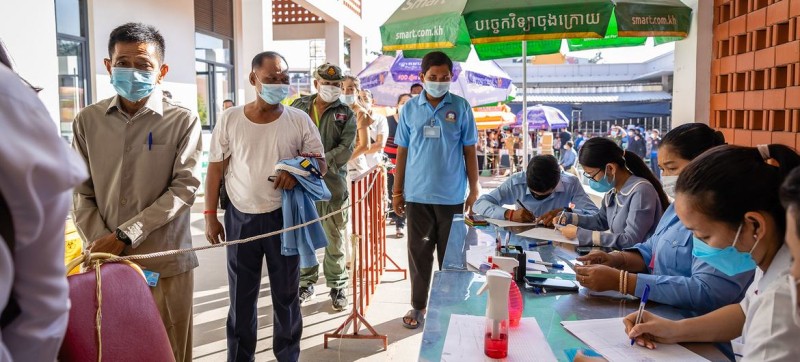© UNICEF/Bunsak But People wait in line to receive their COVID-19 booster shot at a hospital in Phnom Penh, Cambodia.
“Since the peak of the Omicron wave, the number of sequences being shared has dropped by more than 90 per cent, and the number of countries sharing sequences has fallen by a third,” said Tedros Adhanom Ghebreyesus, speaking during his latest media briefing.
Tweet URL
The WHO chief recalled that the first sequence of SARS-CoV-2, the virus that causes COVID-19, was shared with the world three years ago, which enabled the development of tests and vaccines against the disease.
“We urge all countries now experiencing intense transmission to increase sequencing, and to share those sequences,” he said.
Experts assess new variant
A WHO advisory group has published an assessment of the new Omicron subvariant XBB.1.5, which first emerged last October.
Sequences have been reported from 38 countries, though mainly from the United States.
“Based on its genetic characteristics and early growth rate estimates, XBB.1.5 may contribute to increases in case incidence,” said the Technical Advisory Group on Virus Evolution (TAG-VE).
“To date, the overall confidence in the assessment is low, as growth advantage estimates are only from one country, the United States of America.”
Unacceptable death rate
Tedros also emphasized the importance of testing, which is critical both for tracking variants and ensuring at-risk people receive adequate care.
Since February 2022, the number of COVID-19 deaths reported each week has dropped by nearly 90 per cent, but they have been hovering at between 10,000 and 14,000 since mid-September.
“The world cannot accept this number of deaths when we have the tools to prevent them,” he said.
Last week, 11,500 people worldwide died from COVID-19, but “this number is almost certainly an underestimate given the under-reporting of COVID-related deaths in China,” he added.
Countries are also urged to provide better data on who is dying from the disease. Currently, just 53 out of 194 nations provide data that is disaggregated by age and sex.
Most deaths are among at-risk groups, with people 65 and older accounting for almost 90 per cent of all deaths reported during the last six months of 2022.

© UNICEF/Delil Souleiman A mother in Raqqa city, Syria, collects medicine for her children suffering with diarrhoea and also receives instructions on how to sterilize water to guard against cholera.
Widespread cholera outbreaks
Tedros began the briefing by celebrating the end of the Ebola epidemic in Uganda.
He also welcomed the adoption this week of a Security Council resolution extending cross-border aid delivery into northwest Syria from Türkiye for another six months.
Syria, Haiti and Malawi are among 31 countries battling devastating cholera outbreaks that are both more widespread and deadly than normal.
“While we have had large cholera outbreaks before, we have not seen such a large number of simultaneous outbreaks,” said the WHO chief.
“The common denominator for many of these outbreaks is climate-related events, such as storms, floods and droughts.”
China engagement continues
WHO continues to appeal for more information from China regarding its ongoing COVID-19 surge.
The UN agency is working with the authorities to fill important gaps, including in understanding transition dynamics, the breakdown of increases or decreases in hospitalizations, virus sequencing, and differences in fatality rates between urban and rural areas.
“WHO still believes that deaths are heavily underreported from China, and this is in relation to the definitions that are used but also to the need for doctors and those reporting in the public health system to be encouraged to report these cases and not discouraged,” said Dr. Mike Ryan, Executive Director.
He also commended China’s efforts, citing measures such as expanding designated beds in intensive care units and prioritizing the use of antivirals in the early course of the disease.
“There is also a shift in the definition away from COVID pneumonia as the reporting disease, to COVID infection as the main basis for disease reporting, and we hope that that will encourage more reporting – and more reporting to WHO of the true situation on the ground in China,” said Dr. Ryan.
‘Long COVID’ burden
Meanwhile, more research is still needed to better understand the burden of post-COVID-19 condition on human health globally.
Although many people recover from the disease, some patients have persistent symptoms across many different body organs, and over long periods of time, giving way to the condition, commonly known as “long COVID.”
Experts from across WHO are working with counterparts worldwide in the different types of clinical management of cardiac care, brain health and respiratory health.
“What we are targeting is making sure that there is recognition of post-COVID-19 condition, in which this can be described and analyzed,” said Dr. Maria Van Kerkhove, the agency’s lead on COVID-19.
WHO has already published a case definition for long COVID, which is being adapted to cover children, but she said “there is much more work that needs to be done in this space, including recognition, research and rehabilitation.”
Mask up indoors
WHO has encouraged people everywhere to still wear masks, for example in crowded rooms or in places where ventilation is poor or not known.
Dr. Van Kerkhove explained that coronavirus transmission is dependent on factors such as distance between people, setting, ventilation, time spent in the particular location, and mitigation measures that are in place.
“There’s a number of other factors that are important as well, but masks are one of the measures that we recommend when you are indoors when you cannot distance,” she said.
“This is one of the recommendations that we continue to advise, and we are working with governments to tailor the use of this in the right types of contexts.”




Comments are closed.